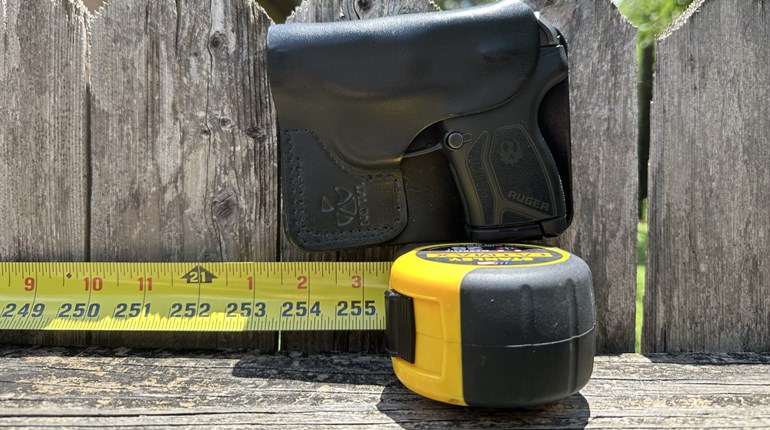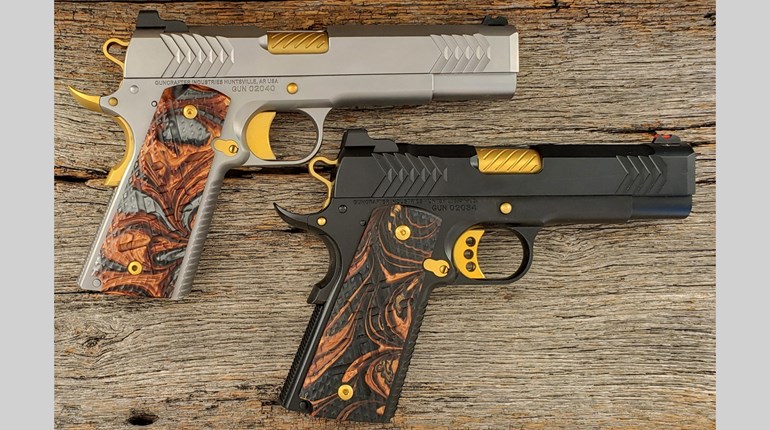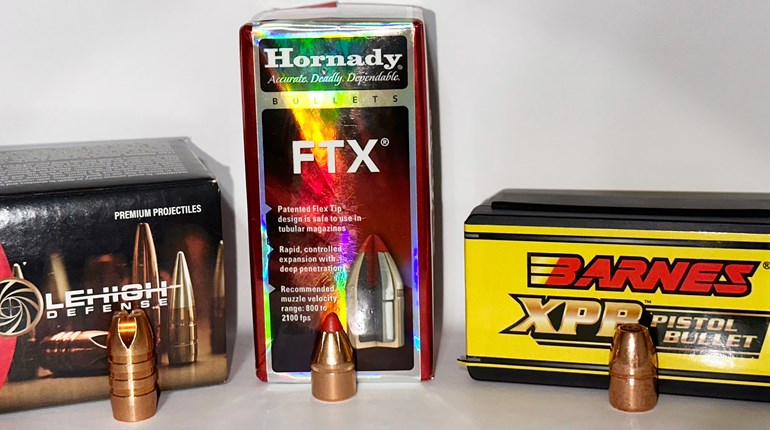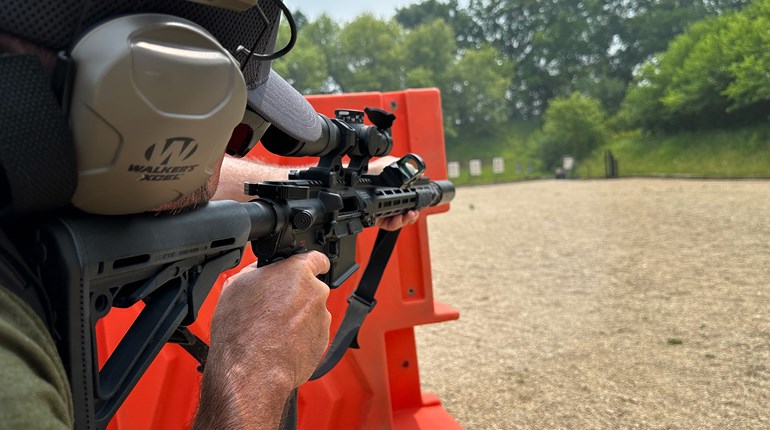
About a year ago, I wrote an article covering .50-caliber pistol cartridges, and the article’s popularity somewhat surprised both the editorial team at SI and myself, so it’s time I give a roundup of the best bullets available to compliment those .50-caliber cartridges. I’ve also taken the liberty to explain what each bullet is ideally suited for and why, to help you narrow down your choices. Keep in mind that this is a handloading proposition, as most companies don’t make many .50-caliber-handgun loads from the factory – if they make any at all.
NOTE: Not all the cartridges in the aforementioned article have published reloading data using the bullets listed here, but all of these bullets can (in theory) be loaded in the .50-caliber cartridges mentioned in the linked article above. Check various sources, as one specific reloading manual may not cover all cartridge/bullet combinations, and feel free to call various bullet manufacturers and see if they did any testing with a combination you may want to try in your firearm. More than once I’ve gotten help finding a starting point for a specific load I wanted to safely try out.
 Hornady FTX
Hornady FTX
Hornady makes three .50-caliber handgun bullets: the 300-grain XTP, the 350-grain XTP Mag. and the most unique of the three, Hornady’s 300-grain FTX bullet. What makes the FTX bullet so special? It’s the only bullet in Hornady’s catalogue of .50-caliber pistol bullets (and this list) to feature a special polymer tip, which Hornady calls the “Flex Tip”. Hornady took the same concept it used in its revolutionary lever-gun bullet (basically, this technology allowed tube-magazine-fed firearms to shoot pointed bullets safely) and put in handgun bullets. The tip is much softer than your average polymer bullet tip found on most tipped bullets, so it compresses easier, allowing the bullet to expand upon impact at lower velocities. This is a major benefit for most handgun projectiles as most of them travel relatively slowly compared to their long-gun counterparts, and this bullet has the highest ballistic coefficient (BC) on this list (for your typical bullet; you’ll see why later). Furthermore, the bullet features Hornady's Interlock Ring to ensure the bullet’s integrity and improve weight retention, thus improving penetration potential and terminal performance.
Bullet Performance Trait: Because this bullet is designed to expand at lower velocities and has the best BC value for its weight, if you plan on taking long shots, the Hornady FTX bullet is probably the best bullet for your needs. MSRP: $57.37; 50 bullets/box
 Barnes XPB
Barnes XPB
While Barnes is known for its pure-copper hunting bullets, it also makes pistol bullets, three of which are the .50-caliber variety. The bullets are available in 50-grain increments: 275 grains, 325, and 375 grains. Featuring Barnes’ patented “X Bullet” technology, the Barnes XPB offers superior weight retention because of its monolithic design. That weight retention is crucial when firing large-caliber handgun bullets. Because both sectional density and speed tend to be lacking in handgun projectiles – yes, even in “magnum” designated cartridges – compared to rifle projectiles, the only way to penetrate deeply is to add mass or speed. This extra mass or velocity becomes even more important with big-bore pistol bullets because the drag coefficient goes up due to the bullet’s increased frontal surface area. All of this to say, because the XPB is one solid piece of copper, there are no weak points that would otherwise cause bullet-jacket separation at higher velocities (even for handgun velocities, this can still happen) as with lead-core bullets, meaning the bullet can be lightened to increase velocity without compromising the XPB’s structural integrity, which normally is what causes a bullet to fail. This is why Barnes makes the lightest bullet on the list at 275-grains. That solid copper, expanding bullet will still penetrate deeply, even though it’s lighter, because it will retain all of its original 275-grain weight.
Bullet Performance Trait: If maximum velocity is your goal, you’re off to the races with the light but capable 275-grain Barnes XPB. MSRP: $27.99-$31.99; 20 bullets/box
 Lehigh Defense Xtreme Penetrator
Lehigh Defense Xtreme Penetrator
Similar in design to hydraulically-stabilized bullets used by African dangerous-game hunters, who want bullets intended for deep penetration through the biggest animals’ densest bones – think large skulls and shoulders – the Lehigh Defense Xtreme Penetrator bullet is the heaviest bullet on the list, with the most massive option coming in at 420 grains (a lighter 350-grain option is available; if you’re wanting the most penetration possible, extra mass is always your friend). I mentioned this bullet as it relates to hunting; Lehigh Defense understands this concept, too, and far better than I do, stating: “The Xtreme Penetrator is the bullet of choice for hunting large, tough and often dangerous game due to the fluid transfer and deep straight-line penetration.”
The bullet’s penetration capabilities are in large part due to its unique nose design featuring radial flutes to create outward hydraulic pressure helping displace tissue. Because the bullet lacks a hollow point, too, the bullet’s design minimizes its frontal surface area by not expanding and keeps all its weight in line with its nose, driving the bullet forward while losing no weight (remember, it’s solid copper) as it travels. People who value penetration know the importance of sectional density. The Xtreme Penetrator has the highest number on the list at .240, which is much higher than nearly all other pistol bullets, and rivals many big-game hunting bullets, such as the standard bullet weights used in .277 (.270/6.8mm), .284 (7mm), and .308 (7.62mm) calibers. Technically, this bullet has the highest BC value out of the bunch, but because it’s so heavy so it can perform as intended, it drops like a rock because its muzzle velocity will be significantly slower than any other bullet on this list.
Bullet Performance Trait: If you’re looking for deep penetration because you prefer an exit wound, there’s no better option than Lehigh Defense’s Xtreme Penetrator bullet; after all, it’s not called the “Xtreme Penetrator” for nothing. MSRP: $49.00; 25 bullets/box
 Speer DeepCurl
Speer DeepCurl
Speer has stuck to tried-and-true designs because those designs simply work; this is why older bullet designs are still around today. This principle applies to the company’s line of “DeepCurl” bullets. Speer electrochemically bonded the DeepCurl’s copper jacket to its lead core to increase weight retention, and while the .50-caliber DeepCurl is advertised to be used in the .50 AE (a pistol cartridge mentioned in the cartridge list above) as a hunting bullet, that doesn’t mean its relegated to that cartridge or that sole purpose, though, admittedly, that would be a solid combination. The one downside to this bullet is that it’s currently unavailable, but when (hopefully not “if” … *cough, cough*, if anyone at Speer is reading this, please bring it back into your production cycle!) it comes back in stock, it’s definitely worth trying out in your .50-caliber pistol cartridge.
Bullet Performance Trait: The bullet has the most frontal surface area of any on the list; combined with its soft lead core, if bullet expansion is your primary objective or your most important metric for bullet performance, the Speer DeepCurl bullet is the .50-caliber bullet for you. MSRP: $31.99; 50 bullets/box
There you have it: the ideal bullet for each metric of bullet performance for use in your .50-caliber pistol cartridge. As a final thought, know that regardless of which bullet you choose to load and why, remember you’re still shooting a .50-caliber bullet; that in and of itself carries quite a bit of weight (pun intended). If anything you shoot and hit well and is able to walk away from any of these projectiles, you likely have a much bigger problem.




































